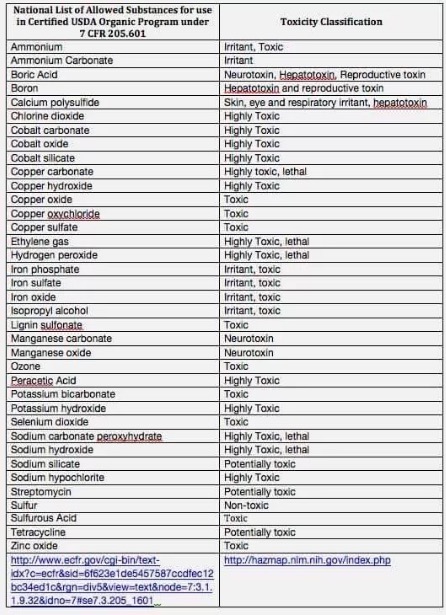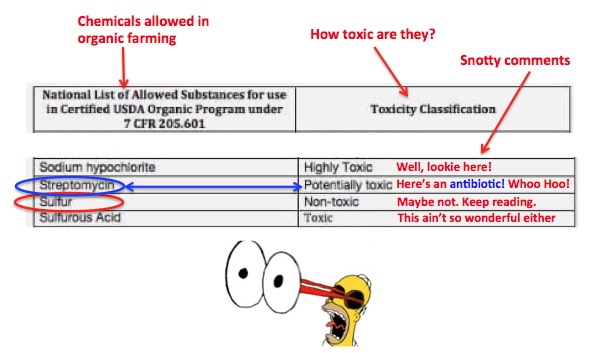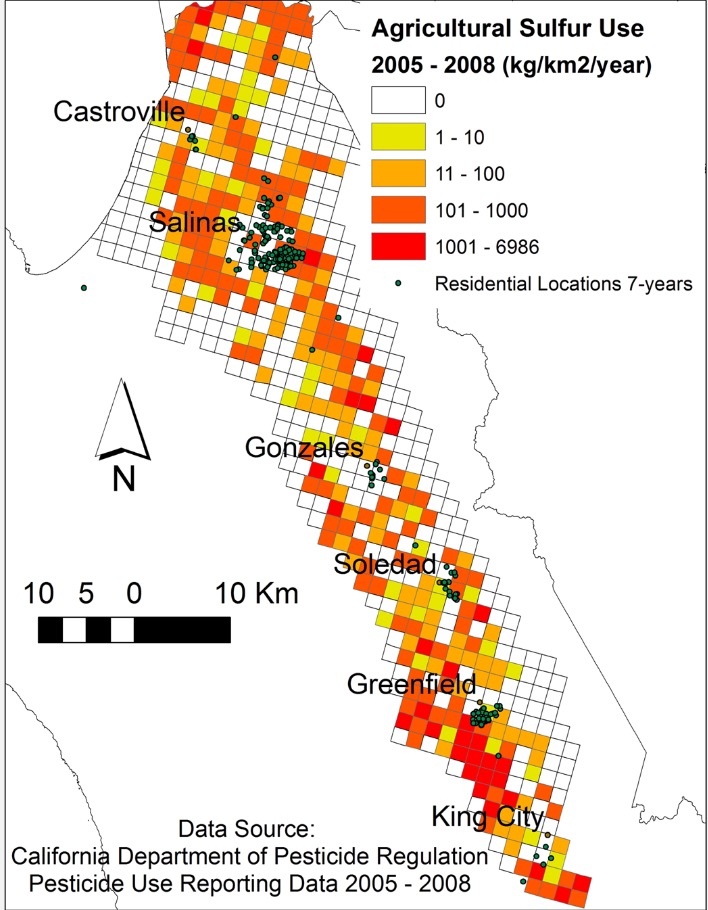
Let's take a poll: Are pesticides used in organic farming?
I mean, how could they possibly be? Isn't that the point of paying a whole lot of money for organic produce so Whole Foods dilettantes can safely enjoy their kale without all those yucky chemicals on it? (1)
This question provides a splendid opportunity to start the week with some...

Monday Myths! (2)
Where to start? There are SO many out there. Here are three...
- Gwyneth Paltrow was spotted at the Harvard Club
- The Knicks will make the playoffs in our lifetime
- Organic produce is grown without pesticides.
At least two of these are plausible, albeit unlikely. Gwyneth Paltrow could have ended up at the Harvard Club, but almost certainly because the Uber guy screwed up and delivered her there instead of...

Anyhow, it's far more likely that she'll be joining the "Hard Time" Club than the Harvard Club, especially given that people, including two California district attorneys, are starting to figure out what garbage she's selling. (See my colleague Dr. Julianna LeMieux's Not Even Paltrow's Goop Is Above The Law)
And #2 is at least possible. The Knicks could make the playoffs. After all, there are a number of articles that predict that people who are born now could live to be 150. In which case, there is at least a remote chance that the NBA world will be rocked to its core during that time. But it isn't terribly likely. The Knicks just aren't very good.

So, we're left with #3. Forget it. Everyone knows that organic produce is grown without pesticides, right? So #3 is most certainly a myth.
Except it's not. Not even close...

List of chemicals that are permitted for organic farming. Source: A Science Enthusiast. A complete list of all allowed and prohibited organic farming chemicals can be found on the U.S. Government Publishing Office site.
Can't see it? Let's blow up a small section of the list...
Four (of many) permitted organic farm chemicals which on the "allowed" list. Is it possible that you've been laboring under a misconception?
Well, this really sucks. One is highly toxic, one is merely toxic, one is an antibiotic (!) and the other is sulfur, which is safe. Except when you breathe it, as you will see shortly. So, you Whole Foods Doods who think you're avoiding chemicals by overpaying for mediocre food - the joke's on you, courtesy of Organic Consumers Association, a corporate front group which has done a superlative job of fooling the American public into believing that their products are chemical-free.

Organic Foods consumer
Now that that little screed is over, let's take a look at what sulfur is doing to asthmatics who happen to live near farms, and breathe in the sulfur non-chemical chemicals. Where is Erin Brockovich when you need her? (3)
A new study in the journal Environmental Health Perspectives should go a long way toward debunking the ridiculous "no chemical" myth that the organic food industry has been spoon feeding the public for so long. Cause if this doesn't punch holes in that nonsense, then nothing can.
Elemental sulfur, a yellow powder, is by every definition a chemical, although it has extremely low toxicity when consumed, so much so that it is all but impossible to even find a dose that will kill test animals - orally. But the lack of oral toxicity does not tell the whole story. When inhaled, sulfur dust isn't nearly as safe (4).
"Acute exposure inhalation of large amounts of [sulfur] dust may cause catarrhal inflammation of the nasal mucosa which may lead to hyperplasia with abundant nasal secretions. Trachiobronchitis [inflammation in the bronchial airways] and tracheais [inflammation of the trachea] airways a frequent occurrence, with dyspnea [difficulty in breathing], persistent cough and expectoration which may sometimes be streaked with blood."
Source: OHS Database. 1993. Occupational Health Services, Inc. 1993 (August) MSDS for Sulfur. OHS Inc., Secaucus, NJ.
And an awful lot of sulfur is used in agriculture; more than 23,000 tons of it was used in California in 2013 alone. The Environmental Health Perspectives study examined for the first time whether inhaled sulfur dust might pose a health risk, especially to with children with asthma. It did. Let's look at the study.

Figure 1: Elemental sulfur use (kg/y) by section of the Public Land Survey System (PLSS) grid in the Salinas Valley, 2005–2008, from the California Pesticide Use Report (PUR) system (CDPR 2013b). The Center for the Health Assessment of Mothers and Children of Salinas
The authors analyzed several breathing functions in children based and correlated them with their distance from farms that used sulfur as a pesticide. The results may or may not take your breath away, but the sulfur sure did with asthmatic kids. In particular:
- When a farm was 1.0 kilometers (or less) from a child's residence there was about a 2-fold increase in respiratory symptoms for asthmatic children. At a distance of 3 kilometers, no effect was seen.
- The use of asthma medications followed a similar pattern.
- Lung function, as measured by FEV1 and FVC (5), was also negatively impacted by proximity to farms, (but not as much as exposure to cigarette smoke) and that the impact grew with the time of exposure.
To be fair, I am often hard on environmental studies, because most of them are pure junk. This one isn't junk, but it's not perfect either. Here are some of the strengths and limitations, as described by the authors.
Strengths:
- The study did not rely solely on questionnaires, which are notoriously unreliable. Objective lung function data obtained from spirometry were used in addition to questionnaires.
- The study cohort population was adjusted for other pesticides (especially organophosphates) present in the area and "sociodemographic confounders."
- The study did not rely on single time points. The sulfur applications were estimated at 1 week, 1 month, and 12 months prior to lung function tests, which were performed on seven-year old children.
- The increased risk was not enormous, but was large enough to (probably) be real - typically 2 to 3.5-fold, depending on the parameter being measured.
Limitations:
- Lung function tests are difficult to perform with young children.
- The sample size was not large, and a 2-fold increase is modest, especially for any study depending on recall.
- Biomarkers are not available for sulfur exposure, so the amount of sulfur inhaled had to be inferred from the distance from the farm.
- Sulfur exposure from other sources was not considered.
In all, it's not a bad study. It's not a bunch of BPA exposure nonsense, nor is it a smoking gun. The study suggests that there may very well be a connection between the sulfur pesticide on farms and respiratory problems in kids, but it's not really clear how bad it is. But this is really beside the point.
The real story here is that this study so clearly demonstrates the carefully calculated misconceptions that Big Organic relies upon to siphon money from your pocket. No - organic farming is not done without chemical pesticides, just different ones. Sorry folks, but if you have been buying into the "chemical-free life" nonsense considered you have spent a whole lot of money on a lie. But don't feel too bad. If you have been fooled by this masterful farce, you are far from alone. You have been the victim of brilliant marketing.
And brilliant marketing causes sales to grow. Organically.
Notes:
(1) I'd rather eat the chemicals than the kale.
(2) Fine. It's not Monday. I'm a bit of a procrastinator. And I was busy watching one of my favorite movies, "Apocalypse Later," so I put it off til Wednesday. So shoot me.
(3) That's an easy one. She's still busy with alchemy - turning chromium into gold - on the talk show circuit, despite the fact that ten years after the movie, an epidemiological study showed that there was no cancer cluster in Hinkley, CA. My colleague Dr. Alex Berezow recently wrote a piece that obliterates the entire false narrative of the movie. It was a bunch of crap.
(4) Sulfur is used as a pesticide on both organic and conventional farms.
(5) FEV (forced expiratory volume)— is the most important lung function test. FEV refers to the amount of air that can be expelled during one second. FVC is the total amount of air that can be expelled after a deep breath. The ratio of the two helps diagnose types of lung disease.



